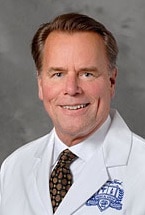Editor’s Note: Today’s post is brought to us by Virginia Ramachandran, AuD, PhD, and Brad Stach, PhD, offering their view of how the recommendations of the PCAST report could actually harm, rather than help, hearing impaired patients.
Audiology Perspective

Virginia Ramachandran, AuD, PhD
When we think of hearing aid care, we think of our patients–the vast majority of whom are over 70 years of age. Most noticed a little bit of hearing loss years before and didn’t pursue hearing aids because they felt they didn’t need them or didn’t feel their problem was “bad enough” to commit the financial and other resources necessary to be successful hearing aid users. Then they reached a certain tipping point in life, and they sought us out as healthcare providers to diagnose, treat, and monitor their chronic communication disorder.
We also know that there are many other patients out there who have hearing loss but simply do not want hearing aids at the present time.
When we think of the cost of hearing aid care, we think of the cost of the device, the cost of our time, our staff’s time, and all of the resources that our institution commits to ensuring safety, quality, and privacy for our patients.
When we think of the hearing aid industry, we think of companies that are driving technological advances at a rapid pace, especially for such a small market. It seems that every season we are learning new and exciting ways to help our patients. We also think of the educators we know from the companies who are working hard to keep us updated on how we can best adapt their technology to our patient’s needs.
Consumer Electronics Perspective

Brad Stach, PhD
Imagine for a moment that we are not us, that instead we are members of the consumer electronics industry. We see hearing aids as electronic devices, not as a part of a process of care for a chronic healthcare condition. We don’t see on a daily basis the otologic disease and other health conditions that impact successful care of our patients.
What we see is a massive economic opportunity. We see an untapped market. We see millions of potential customers who are not buying electronic devices to help their hearing. And why are they not buying these devices?
Well, they tell their doctors and their spouses that hearing aids are too expensive, so it must be the cost.
And it might also be that they are regulated to protect the health and safety of the customers, so it must be the government regulation.
Or perhaps that regulation conspires to keep competition out of the market. Surely customers would buy these devices for their hearing if only we could de-regulate.
The PSAP Clamor
Back to being audiologists, we have seen for years the presence of, but lack of traction for, what are now called PSAPs. That doesn’t surprise us. We know our patients don’t really want hearing aids until they need them.
Still, the PSAP clamor is growing, as is the call for more over-the-counter (OTC) hearing technology solutions. From our patient-centered care perspective, this is at least mildly unsettling. Stated nicely,
“Empirical research on the economic value of patient-centeredness and the importance of trust in the patient-physician relationship shows that a patient’s sense of feeling known, cared for, and understood can directly promote emotional well-being linked to better care, and respect and trust in the patient-physician relationship can improve health through better continuity of care, patient satisfaction, and commitment to treatment plans.” (Berenson and Cassel, 2009)
We certainly know this to be true of the patient-audiologist relationship as well.
PSAPs have been available over-the counter for years and haven’t had much of an impact, so what has changed?
The PCAST Perspective
Recently, the President’s Council of Advisors on Science and Technology (PCAST) released a report to the President of the United States on recommendations that it claims will increase access to hearing care for Americans. Although the focus on hearing loss and care for our aging population is laudable, the report is based on faulty assumptions and a limited evidence base.
In our opinion, the report’s recommendations are dangerous and will not result in greater benefit to our patients. Given that the council purports to support scientific recommendations, it is stunning how much the actual data are ignored in favor of what appears to be a bias toward the consumer electronics industry.
We’ll explain and support those opinions in next week’s post.
References
Berenson, A., and Cassel, C. K. (2009). Consumer-driven health care may not be what patients need – caveat emptor. JAMA, 301(3), 321-323.
Virginia Ramachandran, Au.D., Ph.D., is a senior staff audiologist and research coordinator in the Division of Audiology, Department of Otolaryngology – Head and Neck Surgery of the Henry Ford Health System in Detroit, Michigan. Dr. Ramachandran also coordinates the clinical education experiences of the audiology students at Wayne State University where she is an adjunct assistant professor. She serves as a member of the American Academy of Audiology’s Board of Directors. She is an associate consulting editor for Plural Publishing Inc. and has co-authored and edited several textbooks geared toward audiology students. “The opinions and assertions presented are the private views of the author and are not to be construed as official or as necessarily reflecting the views of the American Academy of Audiology.”
Brad A. Stach, Ph.D. is Director of the Division of Audiology, Department of Otolaryngology-Head and Neck Surgery, of the Henry Ford Hospital in Detroit, Michigan. He also serves as a consultant for Audiology Clinical Education at Wayne State University Department of Communication Sciences and Disorders. Dr. Stach has served in audiology leadership and clinical positions at The Methodist Hospital of Houston, Georgetown University Medical Center, the California Ear Institute at Stanford University, the Nova Scotia Hearing and Speech Clinic, and the Central Institute for the Deaf. He is a founding board member of the American Academy of Audiology and has served as its President and the Chair of its Foundation’s Board of Trustees. Dr. Stach is the author of a number of scientific articles, books, and book chapters and is the Audiology Editor-in-Chief for Plural Publishing.








It is very self-serving to think that the PCAST Recommendations would harm the consumer. The industry is trying to serve their needs rather than the consumer. See my letter to the President:
Dear Mr. President:
I am writing to support PCAST’s Recommendation to open up the market for innovative hearing technologies. However, I believe it doesn’t go far enough. It is just a start. The ‘Recommendation’ should be updated to:
Include accurate hearing loss population numbers.
Require generic names for hearing aid features with a rating system.
The numbers are not fully accurate and do not account for the full hearing loss marketplace.
Hearing loss is a national problem that affects everyone in this country whether directly or indirectly. The letter’s first section severely underestimates the population affected by hearing loss. ‘10% of the population or 48 million people have some form of hearing loss’ versus the ‘30 million (Footnote #2) and 30% over age 65 have some form of hearing loss’ versus the 25% used. (Footnote #1)
PCAST solely looked at the hearing loss market through an older adult lens despite 70% or the vast majority of the hearing loss market being younger than 65. The letter implies that hearing loss is solely an older adult issue. The letter
mischaracterizes the population and how hearing loss impacts the needs of people with hearing loss. One in five teens has some form of hearing loss. Lack of access to quality hearing aids is critical if we are going to change how children with hearing loss grow up, are educated and enter the job market.
On a personal note, my daughter who is 21 has a hearing loss. She continuously worries that she will not be able to afford hearing aids, despite the fact she is starting at an entry level job in a corporate company and she doesn’t have student loans. Lack of access to hearing aids is a huge hurdle to obtain an education. A lack of education impacts future employment.
Hearing loss, while prevalent in older adults, is not just an older adult issue. Omitting children, teens and younger adults from the discussion reinforces the incorrect perception that hearing loss solely affects older adults. Failure to include children and younger adults can then have a ripple effect in legislation and benefits not being available for children and younger adults.
This is not the first time a government or quasi-government agency failed to fully understand hearing loss. A recent CDC study “forgot” hearing loss. The CDC apparently wanted to collect data using phones. Many people with hearing loss cannot use phones. The CDC, rather than change how the data was collected, decided to eliminate hearing loss as a disability. Failing to include hearing loss prevented another opportunity to accurately count people with hearing loss. The agency’s response was essentially a “My bad” when confronted with the omission. The data was not footnoted nor was the omission mentioned.
The balance of the letter, attachments and footnotes can be found at: http://janicelintz.com/2015/12/06/why-the-pcast-recommendations-dont-go-far-enough/
PCAST to FDA: Tear Down That Wall!
https://behearnowblog.wordpress.com/2016/01/21/pcast-to-fda-tear-down-that-wall/
I have not read the PCAST recommendations. However I do know that:
From onset of hearing deficits, to diagnosis of sensorineural hearing loss, the time taken is approximately 26 years. This is easily explained from audiograms taken at an early age, of young adults exposed to industrial noise, till the time they are provided with hearing aids through workmens compensation.
Strangely, the time taken from onset of dementia symptoms to a full blown diagnosis is also 26 years !
Unless there is forced intervention of audiometric testing, hearing impaired persons will continue to avoid hearing aids. This is psychologically plausible, and the only time a reaction to hearing aids is positive is when there is a SSHL, or hearing loss due to trauma.
I believe that socialized medicine will mandate tests regularly on workers and perhaps reduce the ’26 year’ waiting time.
Brad Stach correctly writes,
“Or perhaps that regulation conspires to keep competition out of the market. Surely customers would buy these devices for their hearing if only we could de-regulate.”
The answer is ABSOLUTELY: It’s called “Rent-Seeking Behavior” through “Regulatory Capture” (definitions below). Nowhere did we see more of this when ASHA, AAA & ADA went to war on Capitol Hill fighting IHS’ “Fit to Serve” program, which would help to clear the backlog at the VA. Thanks ladies, you screwed our Vets. Your unprincipled opposition to both Fit to Serve and PCAST exposes your Crony Capitalist demands to protect your turf; and it’s every bit as corrupt as hedge fund managers bribing politicians through their superPACs for the 15% carried interest tax rate.
Dan Schwartz,
Editor, The Hearing Blog
—–
Rent-Seeking Behavior:
“Rent seeking” is one of the most important insights in the last fifty years of economics and, unfortunately, one of the most inappropriately labeled. Gordon Tullock originated the idea in 1967, and Anne Krueger introduced the label in 1974. The idea is simple but powerful. People are said to seek rents when they try to obtain benefits for themselves through the political arena. They typically do so by getting a subsidy for a good they produce or for being in a particular class of people, by getting a tariff on a good they produce, or by getting a special regulation that hampers their competitors. Elderly people, for example, often seek higher Social Security payments; steel producers often seek restrictions on imports of steel; and licensed electricians and doctors often lobby to keep regulations in place that restrict competition from unlicensed electricians or doctors.
More:
http://www.econlib.org/library/Enc/RentSeeking.html
—–
Regulatory Capture:
Regulatory capture is a theory associated with George Stigler, a Nobel laureate economist. It is the process by which regulatory agencies eventually come to be dominated by the very industries they were charged with regulating. Regulatory capture happens when a regulatory agency, formed to act in the public’s interest, eventually acts in ways that benefit the industry it is supposed to be regulating, rather than the public.
Investopedia explains “Regulatory Capture”
Public interest agencies that come to be controlled by the industry they were charged with regulating are known as captured agencies. Regulatory capture is an example of gamekeeper turns poacher; in other words, the interests the agency set out to protect are ignored in favor of the regulated industry’s interests.
http://www.investopedia.com/terms/r/regulatory-capture.asp
—–
Captured Agency:
A government agency, especially a regulatory agency, that is largely under the influence of the economic interest group(s) most directly and massively affected by its decisions and policies — typically business firms (and sometimes professional associations, labor unions, or other special interest groups) from the industry or economic sector being regulated. A captured agency shapes its regulations and policies primarily to benefit these favored client groups at the expense of less organized and often less influential groups (such as consumers) rather than designs them in accordance with some broader or more inclusive conception of the public interest.
http://www.auburn.edu/~johnspm/gloss/captured_agency
More professional opinions without any facts, statistics, or science to back up the claims of harm.
This entire argument against moving forward with reasonable reclassification of ear level electronic devices has everything to do with control of a delivery system by those who simply do not wish to compete for the consumer’s dollars in an open marketplace.
That the average age of the “vast majority” of the patients seen by the above authors speaks directly to a very narrow practice.
The rules changes will allow for greater access, less cost, and more availability, outside of those mandated protocols our learned colleagues would continue to tack onto every fitting, as a means to justify their “Best Practices”
Another way of saying “We know best for everyone. Therefore everything must be done our way.”
“And, since the public doesn’t have our extensive education, they aren’t smart enough to take care of their own needs, or even know what those needs are, so we’ll make all of the decisions about their hearing healthcare for them, lest they cause great harm to themselves in their ignorance.”
No evidence, just professional pomposity fostered large.
As in, the Public is too stupid to make up your own mind regarding the level, or amount of professional care needed, so we will take away your rights to choose what care is appropriate for yourself from you, and replace it with our extensive educational knowledge. For you own good of course. After all we’ve got out AUDs, and PHDs, so we simply know what’s best for everyone, in every case, every time.
Besides, if we have to actually compete for the public’s hearing healthcare dollar, they might choose to go elsewhere, if we can’t force them to see us. Then what would we do?